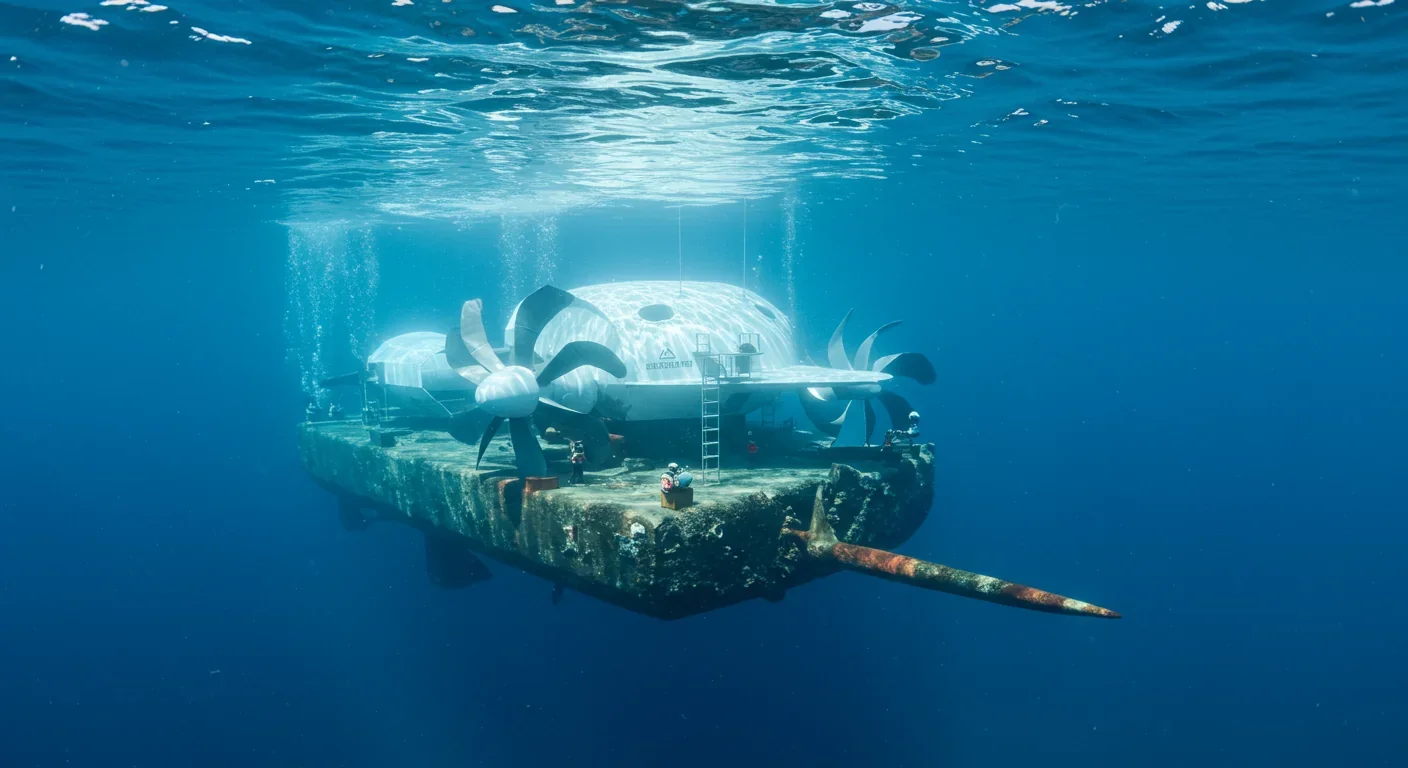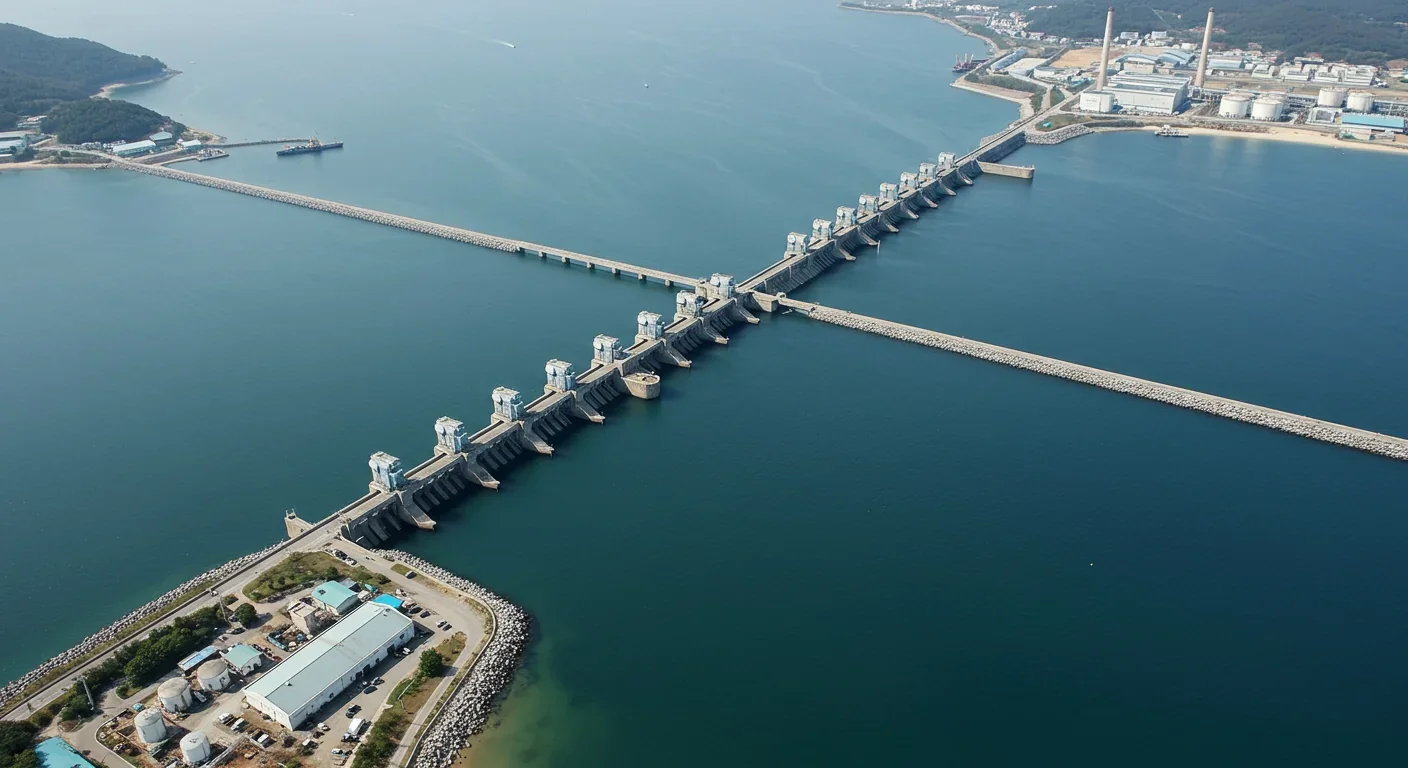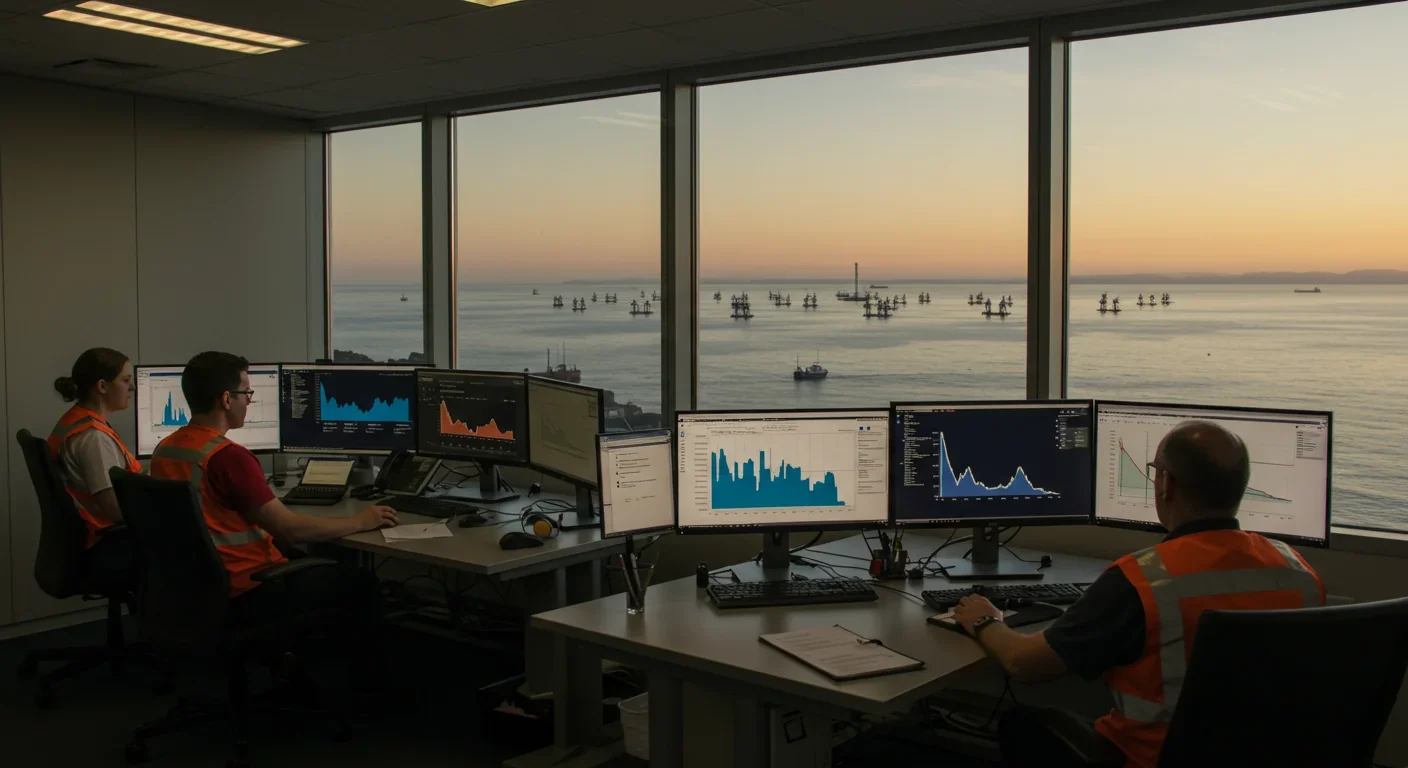Digital Pollution Tax: Can It Save Data Centers?

TL;DR: Tidal energy farms offer predictable renewable power governed by lunar cycles, addressing grid reliability challenges that wind and solar can't solve alone. With proven projects like Scotland's MeyGen and South Korea's Sihwa Lake demonstrating viability, the global market is projected to reach $27 billion by 2033 despite high upfront costs.

By 2033, the global tidal power market will surge to nearly $2 billion, driven by a resource that delivers something wind and solar simply can't match: absolute predictability. While solar panels wait for sunshine and wind turbines hope for gusts, tidal turbines spin on nature's most reliable schedule, governed by celestial mechanics that have been calculable since Newton's time.
The Moon's gravitational pull creates ocean bulges that move across Earth's surface with clock-like precision. This isn't weather-dependent guesswork. Tidal cycles can be forecast years in advance down to the minute, transforming grid operators' perpetual balancing act into something closer to choreography. As renewables dominate more electricity systems worldwide, this reliability becomes less of a nice-to-have and more of a strategic necessity.
Tidal turbines look remarkably like underwater wind farms, but they operate in a medium 800 times denser than air. This density advantage means a slower current packs significantly more energy punch. A tidal turbine's blades rotate as water flows past during flood and ebb tides, converting kinetic energy into electricity through the same generator principles that power your laptop.
Two main approaches dominate tidal energy extraction. Tidal stream generators sit on the seabed like submerged pinwheels, capturing energy from tidal currents without blocking entire waterways. These can be mounted on fixed foundations or floating platforms, offering installation flexibility across different sites. The second approach uses tidal barrages: massive structures built across estuaries that create an artificial height difference between high and low tides, funneling water through turbines as it moves in and out.
The engineering challenge isn't trivial. Marine environments corrode equipment, seabed soil conditions vary wildly, and the machinery must withstand forces that would flatten terrestrial structures. Soft mud layers with shear strengths of just 8-50 kPa can't support heavy foundations. Shallow gas reservoirs pose explosion risks during installation. Yet engineers have cracked these problems, proven by operational farms generating power today.
Grid operators lose sleep over something called the duck curve, a phenomenon where solar generation floods the market during daylight hours and then vanishes precisely when demand peaks in the evening. Wind adds another layer of complexity, surging and dropping based on weather patterns that are predictable days out at best. Tidal energy operates in a different dimension entirely.
Because tidal movements follow lunar cycles, operators know exactly when power will flow months or even years ahead. High tide hits the same location roughly 50 minutes later each day, following a pattern so regular that ancient mariners used it for navigation centuries before electricity existed. This deterministic generation window allows grid managers to schedule baseload power around tidal farms with confidence impossible for other renewables.
The value extends beyond scheduling. Storage requirements drop dramatically when you can predict generation. Battery arrays sized for wind and solar's volatility become oversized for tidal's steady rhythm. Backup capacity needs shrink, reducing infrastructure costs. Wholesale electricity markets gain price stability when predictable supply smooths out demand-driven spikes.
Countries with aggressive decarbonization targets increasingly view tidal energy as the missing puzzle piece. Japan's tidal power market, projected to grow at 8.5% annually through 2033, reflects recognition that intermittent renewables alone can't reliably power industrial economies. Island nations with strong tidal currents hold a geographic advantage that fossil fuel deposits once conferred on oil-rich states.
Scotland's MeyGen project in the Pentland Firth demonstrates what mature tidal technology looks like. Phase 1 deployed four turbines totaling 6 MW capacity starting in 2017, making it the world's largest tidal array. By early 2025, those three operational turbines (one currently offline due to cable fault) were breaking generation records monthly, producing 7.9 GWh in the first half of 2025 alone, up from 5.1 GWh the previous year.
The financial metrics tell an encouraging story. Revenue from electricity sales hit £3.2 million in the same period, nearly doubling year-over-year. More impressively, operating costs dropped from £1.5 million to £1.0 million as the operations team developed expertise in maintenance and turbine management. This learning curve effect proves that tidal farms aren't perpetually expensive novelties but technologies that improve with operational experience.
South Korea's Sihwa Lake installation takes a different approach. At 254 MW, it's currently the world's largest tidal power station, using a barrage system across what was originally a reclamation project. The facility generates power only during flood tide, allowing seawater to flow into the basin through ten bulb turbines. This single-direction operation reduces complexity while still producing substantial output.

France's La Rance facility, operating since 1966 with 240 MW capacity, proves tidal infrastructure's longevity. Nearly six decades of continuous operation demonstrate that properly designed tidal plants outlast their design lifespans significantly. Compare this to solar panels degrading at 0.5-1% annually or wind turbines facing gearbox replacements after 15 years, and tidal's durability advantage becomes clear.
High upfront costs remain tidal energy's Achilles heel. Building underwater infrastructure costs more than planting turbines on land or mounting panels on rooftops. Site-specific designs limit economies of scale that drove down wind and solar prices through mass production. A tidal farm at Scotland's Pentland Firth requires different engineering than one in South Korea's coastal waters, preventing the plug-and-play standardization that made wind turbines commodity products.
India's experience illustrates these challenges. The Gulf of Kutch holds 1,200 MW of theoretical capacity with 8-meter tidal ranges, yet a 1988 feasibility study concluded the project wasn't commercially viable. Estimated costs ran to 6,184 crores for 900 MW capacity. A demonstration project at Durgaduani Creek was estimated at 48 crores but tender responses came in at 238 crores, five times the budget. The project was shelved.
Yet market dynamics are shifting. The wave and tidal power market globally is projected to reach $27.45 billion by 2033, growing at 12.45% annually from $9.76 billion in 2024. Government investment in decarbonization infrastructure, technological improvements reducing installation costs, and growing recognition of predictability's grid value are converging to improve project economics.
Capacity factors matter more than nameplate capacity when evaluating renewable economics. Tidal farms operate roughly 10 hours daily, constrained by tidal cycles rather than equipment limits. This translates to capacity factors around 40-50%, comparable to offshore wind but lower than what designers hope for. However, predictable operation means every kilowatt-hour is schedulable, commanding premium wholesale prices during peak demand periods.
The learning curve that benefited wind and solar is beginning for tidal energy. MeyGen's 33% cost reduction in maintenance demonstrates that operational knowledge compounds. As more projects come online, supply chains develop, specialized vessels become available, and installation procedures optimize. The European Marine Energy Centre in Orkney has been testing tidal devices since 2003, building institutional knowledge that accelerates development timelines.
Tidal energy's environmental scorecard shows green in most categories. Zero greenhouse gas emissions during operation match wind and solar's climate benefits. No air pollution, no water consumption, no mining tailings. The fuel is free, inexhaustible on human timescales, and requires no supply chains vulnerable to geopolitical disruption.
Marine ecosystems face the primary environmental questions. Tidal turbines alter local water flows, potentially disrupting sediment transport patterns that shape coastal habitats. Fish populations that migrate through tidal channels must navigate around or through turbine arrays. Barrage systems, particularly, can dramatically change estuarine ecosystems by altering salinity gradients and water exchange patterns that species have adapted to over millennia.
Research into these impacts remains ongoing. Canada's recent investment in environmental monitoring for Bay of Fundy tidal projects reflects recognition that we need empirical data, not assumptions, to understand long-term ecological effects. Early studies show turbines pose lower collision risks than initially feared, since fish detect pressure changes and avoid blades. Turbine rotation speeds of 10-20 RPM are slow enough for most marine life to navigate around.
Noise pollution deserves consideration. Construction phases create significant underwater sound that can disturb marine mammals using echolocation. Operational turbines produce continuous low-frequency noise, though current evidence suggests impacts are localized rather than widespread. Contrast this with the seismic surveys and drilling operations that fossil fuel extraction requires, and tidal's acoustic footprint shrinks relatively.
Visual impact practically disappears. Underwater turbines are invisible from shore, eliminating the aesthetic concerns that plague onshore wind projects. Barrage systems alter coastlines visibly, but many double as bridges or recreational areas, providing community benefits beyond electricity generation.
Coastal communities hold the key to tidal energy's future, and their perspectives aren't always enthusiastic. New research emphasizes that community engagement must start early and remain genuine throughout project development. Top-down approaches that treat locals as obstacles to overcome rather than partners in energy transition generate opposition that can stall or kill projects regardless of technical merit.
Traditional fishing grounds often overlap with prime tidal energy sites, creating tensions between renewable energy goals and livelihood preservation. Turbine arrays can restrict access to fishing areas, reduce catch volumes if fish behavior changes, or damage nets caught in installations. Some communities view these as acceptable tradeoffs for clean energy jobs; others see them as existential threats to cultural heritage and economic survival.
Job creation offers potential common ground. Tidal projects require construction workers, marine engineers, maintenance crews, and operations staff for decades. Unlike fossil fuel jobs concentrated in extraction regions, tidal energy jobs distribute along coastlines where equipment operates. The European tidal power sector could support thousands of jobs while reducing carbon emissions, creating economic development in coastal regions that industrialization often bypassed.
Revenue-sharing models can align community and developer interests. When local governments or community trusts hold equity stakes in tidal projects, electricity revenues fund schools, infrastructure, or direct payments to residents. The Faroe Islands' renewable energy strategy includes such arrangements, recognizing that community ownership transforms abstract climate goals into tangible local benefits.

Cultural considerations matter beyond economics. Indigenous coastal communities often hold traditional knowledge about tidal patterns, marine ecosystems, and seasonal variations that complements scientific analysis. Consultation processes that genuinely incorporate this knowledge improve project design while respecting sovereignty and cultural practices. Conversely, projects that ignore indigenous concerns face legal challenges, protests, and moral legitimacy questions that financial returns can't outweigh.
Geography determines winners in the tidal energy race as surely as oil deposits shaped 20th-century geopolitics. Coastlines with extreme tidal ranges and strong currents hold overwhelming advantages. The Bay of Fundy between Nova Scotia and New Brunswick experiences 16-meter tidal ranges, among Earth's highest. South Korea's western coast, the UK's northern islands, France's Brittany coast, and select sites in Southeast Asia concentrate most viable global capacity.
This geographic concentration creates strategic implications. Countries blessed with tidal resources gain energy security that's impossible to blockade, embargo, or price-manipulate. Japan's island geography and strong tidal currents offer energy independence that imported LNG never could. The Japanese market's 8.5% projected annual growth reflects national security thinking as much as climate policy.
European leadership in tidal technology development brings both commercial opportunity and diplomatic influence. Companies like Andritz Hydro Hammerfest, Simec Atlantis Energy, and Orbital Marine Power pioneered turbine designs now being exported globally. This technology leadership positions Europe similarly to how China's solar panel manufacturing dominance reshaped energy markets. Intellectual property in tidal systems could become as valuable as lithium deposits if adoption accelerates.
Developing nations with strong tidal resources face different calculations. India's 8,000 MW theoretical tidal capacity could power millions if economics improve, but current costs exceed what many states can justify when coal remains cheap. Southeast Asian nations with growing electricity demand and limited land for solar farms view tidal as a long-term option that current budgets can't prioritize.
International cooperation mechanisms like the International Energy Agency's Ocean Energy Systems initiative facilitate knowledge sharing, but competitive dynamics dominate. Countries developing tidal technology protect intellectual property fiercely, limiting technology transfer that could accelerate global deployment. Climate goals clash with commercial interests, slowing the deployment pace that urgency would otherwise demand.
Scaling tidal energy from niche demonstration projects to mainstream grid component requires solving interconnected technical, economic, and political challenges. Standardization efforts could reduce costs if the industry converges on dominant turbine designs, even while sites remain unique. Modular approaches that mix-and-match standardized components offer a middle path between full customization and mass production.
Grid integration technology must evolve alongside generation capacity. Smart grids that can dynamically balance predictable tidal power, variable wind, and solar with demand patterns will extract maximum value from each source's strengths. Energy storage sized for filling tidal slack periods rather than days of calm weather costs less while maintaining reliability.
Policy support remains crucial during the industry's vulnerable early growth phase. Feed-in tariffs that pay premium prices for tidal electricity help projects achieve financial viability until scale effects drive costs down. Research funding into turbine efficiency, installation techniques, and environmental monitoring accelerates learning curves. Streamlined permitting processes that maintain environmental standards while avoiding bureaucratic redundancy encourage investment.
The IEA forecasts that tidal and wave energy could contribute 300 GW of global capacity by 2050, up from today's 0.5 GW. This 600-fold increase sounds ambitious, but it mirrors the explosive growth wind and solar experienced once economics tipped in their favor. Current globally installed tidal capacity roughly equals where wind power stood in 1990, three decades before wind turbines became ubiquitous.
Climate goals make tidal energy's growth not just likely but necessary. Completely decarbonized electricity systems need baseload power that doesn't depend on weather. Nuclear provides one option, but public opposition and construction timelines limit its expansion. Tidal energy offers the predictable generation that complements intermittent renewables without the radioactive waste or meltdown risks that make nuclear contentious.
Within a decade, you'll likely see tidal power contributing to electricity grids in ways barely visible today. Coastal cities could run partially on ocean power, their streetlights brightening on schedules set by the Moon rather than coal plants. Industrial facilities with high energy demands might locate near tidal-rich coastlines, accessing electricity as reliable as any fossil fuel plant but cleaner than burning wood.
The question isn't whether tidal energy becomes part of the renewable energy mix, but how quickly cost curves drop, how effectively communities and developers collaborate, and whether political will matches climate rhetoric. The tides will keep rising and falling regardless, driven by gravitational forces older than humanity. Whether we harness that inexhaustible power or watch it surge past unused depends entirely on choices being made in design labs, boardrooms, and government offices today.

Recent breakthroughs in fusion technology—including 351,000-gauss magnetic fields, AI-driven plasma diagnostics, and net energy gain at the National Ignition Facility—are transforming fusion propulsion from science fiction to engineering frontier. Scientists now have a realistic pathway to accelerate spacecraft to 10% of light speed, enabling a 43-year journey to Alpha Centauri. While challenges remain in miniaturization, neutron management, and sustained operation, the physics barriers have ...

Epigenetic clocks measure DNA methylation patterns to calculate biological age, which predicts disease risk up to 30 years before symptoms appear. Landmark studies show that accelerated epigenetic aging forecasts cardiovascular disease, diabetes, and neurodegeneration with remarkable accuracy. Lifestyle interventions—Mediterranean diet, structured exercise, quality sleep, stress management—can measurably reverse biological aging, reducing epigenetic age by 1-2 years within months. Commercial ...

Data centers consumed 415 terawatt-hours of electricity in 2024 and will nearly double that by 2030, driven by AI's insatiable energy appetite. Despite tech giants' renewable pledges, actual emissions are up to 662% higher than reported due to accounting loopholes. A digital pollution tax—similar to Europe's carbon border tariff—could finally force the industry to invest in efficiency technologies like liquid cooling, waste heat recovery, and time-matched renewable power, transforming volunta...

Humans are hardwired to see invisible agents—gods, ghosts, conspiracies—thanks to the Hyperactive Agency Detection Device (HADD), an evolutionary survival mechanism that favored false alarms over fatal misses. This cognitive bias, rooted in brain regions like the temporoparietal junction and medial prefrontal cortex, generates religious beliefs, animistic worldviews, and conspiracy theories across all cultures. Understanding HADD doesn't eliminate belief, but it helps us recognize when our pa...

The bombardier beetle has perfected a chemical defense system that human engineers are still trying to replicate: a two-chamber micro-combustion engine that mixes hydroquinone and hydrogen peroxide to create explosive 100°C sprays at up to 500 pulses per second, aimed with 270-degree precision. This tiny insect's biochemical marvel is inspiring revolutionary technologies in aerospace propulsion, pharmaceutical delivery, and fire suppression. By 2030, beetle-inspired systems could position sat...

The U.S. faces a catastrophic care worker shortage driven by poverty-level wages, overwhelming burnout, and systemic undervaluation. With 99% of nursing homes hiring and 9.7 million openings projected by 2034, the crisis threatens patient safety, family stability, and economic productivity. Evidence-based solutions—wage reforms, streamlined training, technology integration, and policy enforcement—exist and work, but require sustained political will and cultural recognition that caregiving is ...

Every major AI model was trained on copyrighted text scraped without permission, triggering billion-dollar lawsuits and forcing a reckoning between innovation and creator rights. The future depends on finding balance between transformative AI development and fair compensation for the people whose work fuels it.